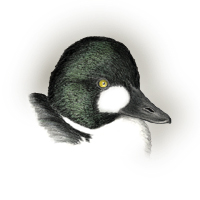|
Field
Guide IDs: BREEDING:
Ponds, lakes,
rivers and coastal bays, wooded marshy habitat. 1
brood. DISPLAYS:
See:
Duck
Displays. NEST:
Cavity in tree near
water. Lined with chips and down, increasing to
thick blanket as incubation advances. EGGS:
Light-green/olive-green.
2.4" (60 mm). DIET:
In fresh water,
aquatic insects, crayfish, fish; some aquatic veg.
In salt water, crustaceans, mollusks. CONSERVATION:
Winters within N.A.
Readily use nest boxes. NOTES:
Where nests scarce,
females parasitize each other, resulting in
clutches often >30 eggs; if parasite's egg(s)
added early in laying, nesting female
proportionately reduces the number of eggs she
lays. Young remain in nest 24-42 hours. Deserted
broods occ aggregate in crèches. Do not
breed until second year. Yearlings and failed
nesters (females) "prospect" for future nest sites
while other females are incubating, or shortly
after hatching. Males winter farther n than
females, who winter farther n than
juveniles. ESSAYS: Parasitized
Ducks;
Dabblers
vs. Divers;
Crèches;
Feathered
Nests;
Migration. REFERENCES:
Andersson and
Eriksson, 1982; Bellrose, 1976; Dane and Van der
Kloot, 1964; Eadie and Gauthier, 1985; Gooders and
Boyer, 1986. |
